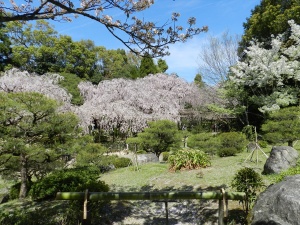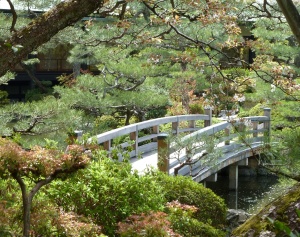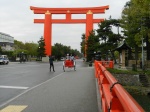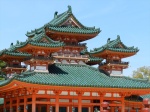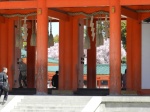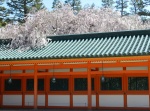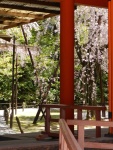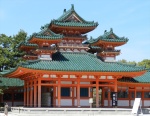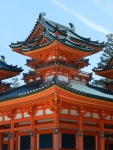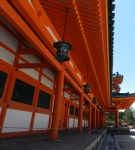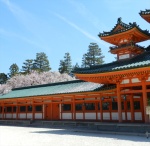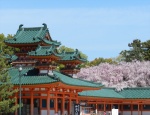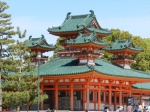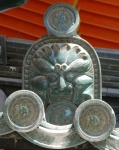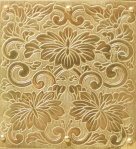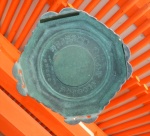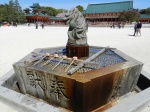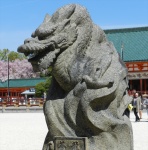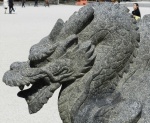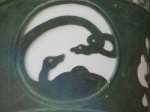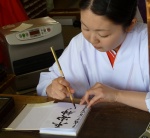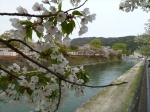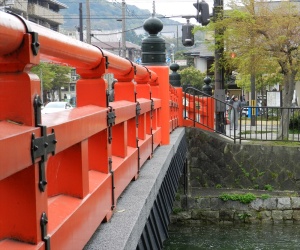Heian-Jingu Shrine
By Jim Caldwell
Night time cherry blossoms in Kyoto.
The gardens are absolutely beautiful so allow at least half a day to enjoy.
Built in 1895, Heian Jingu Shrine commemorates 1100th anniversary of Emperor Kanmu’s (737-806) relocation of the Japan’s capital in 794 from Nara to Heian-kyō, or present day Kyoto. The Shinto shrine is dedicated to Emperor Kammu and Emperor Kōmei (1831-1866). Emperor Kōmei was to fully reside in Heian before Emperor Meiji moved the capital to Tokyo.
Heian Jingu hosts three of Kyoto’s most important festivals. In early January, the shrine plays host to the festival honoring Emperor Kōmei. Then in early April, the shrine honors Emperor Kammu. In October, Heian Jingu hosts the Jidai Matsuri, one of the three most important festivals of Kyoto. The procession of this festival begins at the old Imperial palace, and includes carrying the mikoshi (portable shrines) of Emperors Kammu and Komei to the Heian Jingu.
Heian Jingu Shrine is also famous for its gardens. Crafted over 20 years by one of Japan’s master landscapers, Jihei Ogawa, the gardens of Heian Jingu’s stylistically are born out of the Meiji-era (1868-1912. Made up of four gardens: Higashi Shin’en (East Garden), Minami Shin’en (South Garden), Naka Shin’en (Middle Garden) and Nishi Shin’en (West Garden).
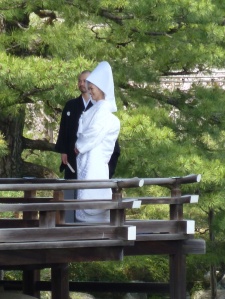
Japanese bride and groom at Heian-Jingu Shrine Shobi-kan after Shinto wedding ceremony. Kyoto shrine during cherry blossom season in Spring time.
(Click to view more Traditional Japanese
Shinto Wedding at Heian Jingu Shrine pictures)
Ogawa created a center water focus of the ponds draw the landscape elements to the architecture. Heian-Jingu’s gardens have been created to capture Japan’s natural beauty through the seasonal changes. With an ode to the Heian Period and hanami, the viewing of cherry blossoms, take on a special cultural importance during spring. The ponds, themselves, contain rare species like the Striped Bitterling fish, the Yellow Pond Turtle and the Japanese Pond Turtle.
The Minami Shin’en, or South Garden, may be Heian Jingu Shrine’s most popular garden and photographed. Famous for its shidarezakura, or weeping cherry tree, Minami Shin’en, has become one of Kyoto’s and Japan’s most important places for hanami. The gardens remain open through the evening during sakura and summer. In the early summer, the South Garden’s azaleas flower spectacularly. As the fall approaches, Minaimi’s bush clove add to the garden’s color. If you are lucky enough you may get to enjoy a concert during hanami and summer seasons.
(Click to view more Cherry Blossom Season at Heian-Jingu Shrine)
As one of the original Heian Jingu’s gardens from around 1895, the West Garden, or Nishi Shin’en, with a pond named Byakko-ike takes on a quietness creating an aura of serenity. When summer comes around, the West Garden comes alive as the irises flower through much of the season. The garden’s cherry-blossom arbor, Choshin-tei, becomes home for many of the shrine’s traditional tea ceremonies.
(Click to view more Landscape and Garden pictures)
Another one of Heian-Jingu’s original gardens, Naka Shin’en (Middle Garden) was also created in 1895. One of the garden’s centerpieces is its pond, Soryu-ike. At one end of the pond round stone pillars create a water pathway called Garyu-kyu. The pillars are from two of Kyoto’s most prominent bridges Gojo Ohashi and Sanjo Ohashi. Like Nishi Shin’en, during the summer months irises come alive with color in Naka Shin’en. The garden is right Heian Jingu’s main buildings.
Like other gardens, a water feature ties all the elements together as one in the East Garden. With the Higashiyama Hills in the background, Heian Jingu Shrine’s East Garden’s pond, Seiho-ike, its garden and the buildings Taihei-haku and Shobi-kan draw together as one Kyoto’s shrines most photogenic spots. The East Garden is known as Higashi Shin’en in Japanese.
Located in the northern part of Kyoto’s, Heian Jingu Shrine can found between the Kamo River and the Path of Philosophy, The main entrance to the shrine is on Marutamachi street, and a path called Jingu-michi links Kyoto Museum of Art, Okazaki Park, Maruyama Park, Yasaka Shrine and the Zoological Garden.
The shrine is also home to some of Kyoto’s most famous landmarks. Originally Heian was supposed to have a full size reproduction of the Heian Palace. Failure to secure enough land necessitated the reproduction to be built at fife-eights scale. Other notable landmarks at the shrine are the Grand Shrine Gate (or tortii), the Ōten-mon or Main Gateway, the courtyard and Daigoku-den (Outer Sanctuary), the Byakko-ro (White Tiger Tower), the Tahei-kaku (Hashidono) and Shobi-kan (Kihin-kan) to name just a few.
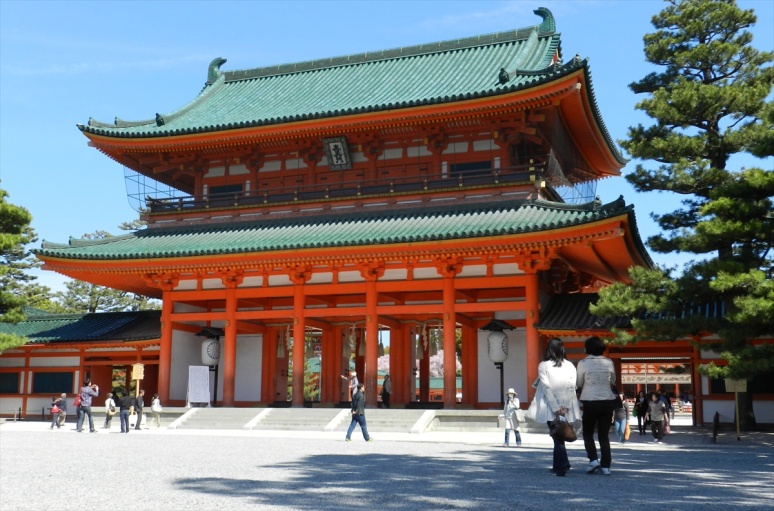
The Oten-mon gate at Heian Jingu Shrine was built in 1894. It is a reproduction of the original gate at the Kyoto Imperial Palace.
- Otorii – Grand Shrine Gate to Heian Jingu Shrine Kyoto. Built out of concrete in 1929 as the entrance to commemorative Heian Imperial Palace.
- Vermilion-colored look-outs at roof center and at four corners built in 1894. The Soryu-ro, also known as the Blue Dragon tower is the East Tower beside Daigoku-en.
- The Heian Jingu Shrine’s entrance is through the vermillion Ote-mon gate. This is the main courtyard with the Daigoku-den or Palace of the State Hall. Japanese Shinto Shrine in Kyoto
- Japanese Cherry Blossoms at Soryu-ro – Heian Jingu Shrine Kyoto
- Weeping Cherry Blossoms at Kyoto’s Heian Jingu Shrine. photography Jim Caldwell Redondo Beach
- Byakko-ro are Lookout for Soryu-ro Heian Jingu Shrine Kyoto. The Soryu-ro, also known as the Blue Dragon tower is the East Tower beside Daigoku-en. photography Jim Caldwell Redondo Beach
- Byakko-ro are Lookout for Soryu-ro Heian Jingu Shrine Kyoto. The Soryu-ro, also known as the Blue Dragon tower is the East Tower beside Daigoku-en. photography Jim Caldwell Redondo Beach
- Lanterns on Heian Jingu Shrine’s Soryu-ro porch. The placement and lighting of Japanese lanterns can have particular significance to religious and social groups.
- Byakko-ro are Lookout for Soryu-ro Heian Jingu Shrine Kyoto. The Soryu-ro, also known as the Blue Dragon tower is the East Tower beside Daigoku-en. photography Jim Caldwell Redondo Beach
- Byakko-ro are the vermilion-colored look-outs at roof center and at four corners built in 1894. The Soryu-ro, also known as the Blue Dragon tower is the East Tower beside Daigoku-en.
- Byakko-ro are the vermilion-colored look-outs at roof center and at four corners built in 1894. The Soryu-ro, also known as the Blue Dragon tower is the East Tower beside Daigoku-en.
- Heian Jingu Shrine Dragon Tapestry. Most Japanese Shinto dragons are depicted as large, wingless, serpentiness with clawed feet. photography Jim Caldwell Redondo Beach
- Heian Jingu Shrine Dragon Tapestry. Most Japanese Shinto dragons are depicted as large, wingless, serpentiness with clawed feet. photography Jim Caldwell Redondo Beach
- Heian Jingu Shrine Sake Sakadaru. Sake has always been a way to bring gods and people together, brewers donate the sake that shrines need for ceremonies and festivals.
- Heian Jingu Shrine decorative image
- Heian Jingu Shrine decorative panel
- Heian Jingu Shrine decoration
- Every Shinto shrine provides water for washing the hands and rinsing the mouth before approaching the shrine. Japanese dragons are often thought of as water deities. photography by Jim Caldwell Redondo Beach
- The Japanese Shinto dragons derive out Chinese Bhuddist origin. Shinto dragons are often associated with water purifcation since dragons are believed to come or live in the water.
- The Japanese Shinto dragons derive out Chinese Bhuddist origin. Shinto dragons are often associated with water purifcation since dragons are believed to come or live in the water.
- Japanese lantern ornamentation at Heian Jingu Shrine Kyoto. The dragon represents Shinto purification and are considered kami in Japan. Heian Jingu is in Kyoto.
- How to go to the bathroom in Japan. Japanese show how to be hygienic in this bathroom poster.
- Japanese woman in a kimono at Heian Jingu Shrine writing with a brush
- Okazaki Canal near Heian Jingu during cherry blossom season
- Ornamental feature at Heian Jingu Shrine Kyoto
- The Welsh Corgi on a visit to Heian Jingu Shrine in Kyoto taking in the Shinto life.
- Heian Jingu Shrine and Shinto in Kyoto
(Click to view More Photos Outside Heian-Jingu Shrine in Kyoto)
Next, night photo of Kyoto Business district.
.


